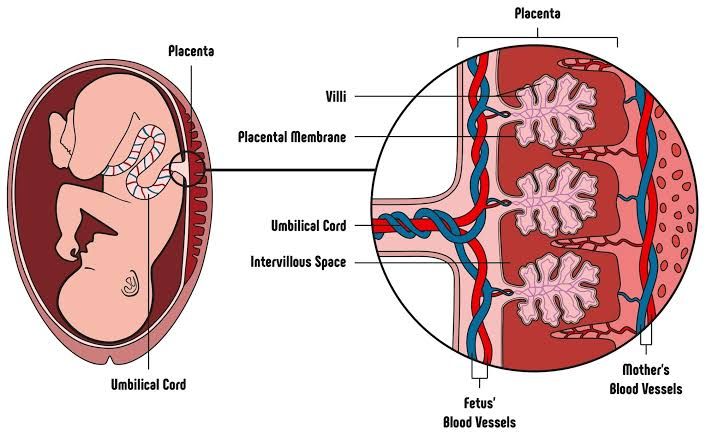
The placenta is a vital organ that develops during pregnancy, facilitating the exchange of nutrients and waste between the mother and fetus. It performs several critical functions, including barrier, nutritive, respiratory, excretory, and endocrine functions. Additionally, various placental abnormalities can affect these functions, leading to complications such as placental insufficiency.
Placental Functions
1. Barrier Function
The placenta acts as a selective barrier between maternal and fetal blood supplies. It prevents the passage of harmful substances such as pathogens (e.g., bacteria and viruses) and certain drugs while allowing essential nutrients and gases to pass through. The trophoblast layer of the placenta plays a crucial role in this function by forming tight junctions that regulate what enters the fetal circulation.
2. Nutritive Function
The placenta is responsible for transferring essential nutrients from the mother to the fetus. Key nutrients include glucose, amino acids, fatty acids, vitamins, and minerals. This transfer occurs through active transport mechanisms and facilitated diffusion across the placental membrane.
3. Respiratory Function
The placenta facilitates gas exchange between maternal and fetal blood. Oxygen from maternal blood diffuses into fetal blood while carbon dioxide produced by the fetus diffuses back into maternal circulation for exhalation. This process is crucial for maintaining adequate oxygen levels for fetal development.
4. Excretory Function
The placenta helps remove metabolic waste products from the fetus’s blood into the maternal circulation. Waste products such as urea and creatinine are transferred from fetal blood to maternal blood for elimination by the mother’s kidneys.
5. Endocrine Function
The placenta produces several hormones that are vital for maintaining pregnancy and supporting fetal development. These hormones include:
- Human Chorionic Gonadotropin (hCG): Maintains corpus luteum function in early pregnancy.
- Progesterone: Supports uterine lining maintenance.
- Estrogens: Promote uterine growth and prepare breasts for lactation.
- Human Placental Lactogen (hPL): Modulates maternal metabolism to ensure adequate nutrient supply to the fetus.
Placental Abnormalities
Various abnormalities can occur in the placenta that may impair its functions:
1. Placenta Previa
This condition occurs when the placenta partially or completely covers the cervix, leading to complications during delivery such as bleeding or preterm birth.
2. Placental Abruption
This refers to premature separation of the placenta from the uterine wall, which can cause severe bleeding and compromise oxygen delivery to the fetus.
3. Intrauterine Growth Restriction (IUGR)
IUGR can result from placental insufficiency where inadequate nutrient transfer leads to poor fetal growth.
4. Chorioamnionitis
An infection of the placental membranes can lead to inflammation that affects placental function and increases risks of preterm labor or neonatal infections.
These abnormalities can significantly impact both maternal health and fetal development, necessitating careful monitoring throughout pregnancy.
Placental Insufficiency
Placental insufficiency occurs when the placenta fails to deliver an adequate supply of oxygen and nutrients to the fetus, potentially leading to adverse outcomes such as IUGR or stillbirth.
Investigations for Placental Insufficiency
Several investigations are used to diagnose placental insufficiency:
- Ultrasound Examination: This imaging technique assesses fetal growth patterns, amniotic fluid levels, and placental location.
- Doppler Studies: Doppler ultrasound evaluates blood flow in umbilical arteries; abnormal flow patterns may indicate compromised placental function.
- Biophysical Profile (BPP): This combines ultrasound with non-stress tests to assess fetal well-being based on movement, tone, breathing movements, heart rate reactivity, and amniotic fluid volume.
- Maternal Blood Tests: Certain biomarkers in maternal serum may indicate placental dysfunction or stress.
These investigations help guide clinical management decisions aimed at optimizing outcomes for both mother and child.
In summary, understanding placental functions along with recognizing abnormalities is crucial for managing pregnancies effectively while addressing potential complications associated with placental insufficiency.






